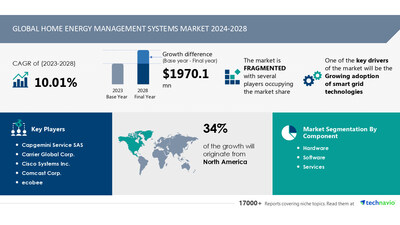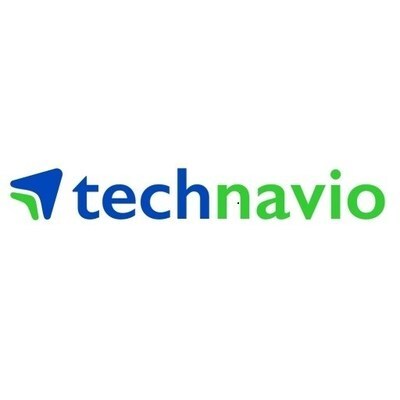The home energy management systems market is projected to grow by USD 1.97 Billion from 2024-2028, with AI impacting trends and rising smart grid adoption driving revenue – Technavio
Press Releases
Sep 24, 2024
NEW YORK, Sept. 24, 2024 /PRNewswire/ — Report on how AI is redefining market landscape – The Global Home Energy Management Systems market size is estimated to grow by USD 1.97 billion from 2024-2028, according to Technavio. The market is estimated to grow at a CAGR of 10.01% during the forecast period. Growing adoption of smart grid technologies is driving market growth, with a trend towards growing investment in smart cities and smart homes However, high cost of implementation and interoperability issues poses a challenge – Key market players include Capgemini Service SAS, Carrier Global Corp., Cisco Systems Inc., Comcast Corp., ecobee, Emerson Electric Co., General Electric Co., Honeywell International Inc., Intel Corp., Johnson Controls International Plc., Lennox International Inc., Liricco Technologies Ltd., Panasonic Holdings Corp., Resideo Technologies Inc., Robert Bosch GmbH, Schneider Electric SE, Siemens AG, Snap One LLC, tado GmbH, and Vivint Inc..
AI-Powered Market Evolution Insights. Our comprehensive market report ready with the latest trends, growth opportunities, and strategic analysis- View your snapshot now
|
Forecast period |
2024-2028 |
|
Base Year |
2023 |
|
Historic Data |
2018 – 2022 |
|
Segment Covered |
Component (Hardware, Software, and Services), Product (Lighting controls, Programmable thermostats, Self-monitoring systems, and Advanced central controllers), and Geography (North America, Europe, APAC, South America, and Middle East and Africa) |
|
Region Covered |
North America, Europe, APAC, South America, and Middle East and Africa |
|
Key companies profiled |
Capgemini Service SAS, Carrier Global Corp., Cisco Systems Inc., Comcast Corp., ecobee, Emerson Electric Co., General Electric Co., Honeywell International Inc., Intel Corp., Johnson Controls International Plc., Lennox International Inc., Liricco Technologies Ltd., Panasonic Holdings Corp., Resideo Technologies Inc., Robert Bosch GmbH, Schneider Electric SE, Siemens AG, Snap One LLC, tado GmbH, and Vivint Inc. |
Key Market Trends Fueling Growth
The smart home market is experiencing significant growth as consumers seek to enhance convenience and efficiency in their living spaces. Advanced sensors and affordable technologies enable homeowners to connect and control appliances such as heating systems, lighting, air conditioning, computers, TVs, entertainment systems, security devices, and cameras using smartphones and tablets. Artificial intelligence predicts consumer preferences based on historical data. The rise of smart homes is driven by the increasing number of working couples with dual incomes in North America, Europe, and emerging economies in APAC. Governments worldwide are investing in smart city projects, particularly in the Middle East, increasing the demand for home energy management systems and fueling the growth of the global market.
The Home Energy Management Systems (HEMS) market is experiencing significant growth due to increasing concerns over greenhouse gas emissions and the need to reduce energy consumption. This Industry Analysis Report covers trends such as the adoption of hybrid technology, IoT technologies, and machine learning in HEMS. Key players like Iberdrola are leading the way with advanced central controllers, intelligent HVAC controllers, and self-monitoring systems. New construction and multi-family residences are embracing smart home technologies, including programmable communicating thermostats and smart meters. Deployment types include cloud deployment and Wi-Fi, with financial incentives like rebates and tax credits driving adoption. HEMS also supports smart grid development and EV charging. Power consumption data analytics and electricity usage patterns help homeowners reduce energy bills and carbon footprints. Advanced data analytics and artificial intelligence further optimize energy management strategies. Wireless protocols technology ensures seamless integration of various HEMS components. Overall, HEMS is a crucial technology for smart building development and reducing carbon footprints.
Insights on how AI is driving innovation, efficiency, and market growth- Request Sample!
Market Challenges
- Home energy management systems (HEMS) offer significant energy savings by allowing homeowners to monitor and control their energy consumption in real-time. However, the high initial investment required to install these systems, which includes sensors, displays, software, and professional installation of smart thermostats, discourages many homeowners from adopting HEMS. The average cost of a smart thermostat ranges from USD250 to USD350, and additional installation fees add to the expense. Furthermore, maintenance costs are also high, increasing the overall cost of ownership. Another challenge is the use of proprietary communication technologies by various smart devices, which necessitates the use of a single platform or hub to ensure seamless integration and automation. This limits consumer choice and requires a significant investment in a single provider or multiple hubs, which may hinder the growth of the global HEMS market. In summary, the high initial and ongoing costs, along with the need for a single proprietary platform or hub, present significant barriers to the adoption of home energy management systems. These challenges may negatively impact the growth of the global HEMS market during the forecast period.
- The Home Energy Management Systems (HEMS) market is experiencing significant growth due to increasing concerns over greenhouse gas emissions and the need to reduce energy consumption and costs. The market comprises hardware like intelligent HVAC controllers, programmable communicating thermostats, and lighting controls, as well as software solutions and self-monitoring systems. HEMS utilizes hybrid technology, IoT, machine learning, and advanced data analytics, including artificial intelligence. Key players like Iberdrola are driving innovation through smart building development and smart grid integration. New construction and multi-family residences are prime targets for HEMS implementation. Financial incentives such as rebates, tax credits, and carbon footprint reduction are major drivers. HEMS also supports smart home technologies like Wi-Fi, Ethernet, and wireless protocols. The future of HEMS includes integration with electric vehicles (EVs), advanced central controllers, and cloud deployment for energy management strategies.
Insights into how AI is reshaping industries and driving growth- Download a Sample Report
Segment Overview
This home energy management systems market report extensively covers market segmentation by
- Component
- 1.1 Hardware
- 1.2 Software
- 1.3 Services
- Product
- 2.1 Lighting controls
- 2.2 Programmable thermostats
- 2.3 Self-monitoring systems
- 2.4 Advanced central controllers
- Geography
- 3.1 North America
- 3.2 Europe
- 3.3 APAC
- 3.4 South America
- 3.5 Middle East and Africa
1.1 Hardware- The home energy management system market is driven by the growing adoption of advanced hardware components. This hardware includes a hub device that communicates between home events, users, and sometimes utilities or electricity retailers. Additional components, such as smart plugs, light sensors, and temperature sensors, can also be integrated. As communication and sensing technology advances, hardware is becoming a significant market focus. Wired sensor networks, with their increased reliability, longer service lives, and reduced interference, are gaining popularity. The expansion of the hardware segment is expected to boost the home energy management system market, as monitoring and controlling building operations becomes more prevalent. Consequently, the global home energy management systems market is anticipated to grow substantially during the forecast period.
Download complimentary Sample Report to gain insights into AI’s impact on market dynamics, emerging trends, and future opportunities- including forecast (2024-2028) and historic data (2018 – 2022)
Research Analysis
The Home Energy Management Systems (HEMS) market is a rapidly growing sector in the energy industry, focused on optimizing energy consumption and cost savings in residential and commercial applications. HEMS integrates hardware and software solutions, including thermostat systems, intelligent HVAC controllers, and advanced central controllers, to manage and monitor energy usage in real-time. Wireless protocols technology, hybrid systems, and IoT integration are key trends driving market growth. New construction and deployment type are crucial factors influencing the market’s development. Industry Analysis Reports provide insights into market size, growth, trends, and opportunities. HEMS technology encompasses smart homes, electric vehicles (EVs), and lighting controls, with AI, machine learning, and advanced data analytics enhancing system capabilities. Wi-Fi and Ethernet are common communication protocols in HEMS.
Market Research Overview
The Home Energy Management Systems (HEMS) market is a rapidly growing sector in the energy industry, focused on optimizing energy usage and reducing carbon footprints in residential and commercial buildings. HEMS utilizes advanced central controllers, data analytics, artificial intelligence, and machine learning to analyze electricity usage patterns and provide energy management strategies. Cloud deployment enables remote monitoring and control of power consumption, while IoT technologies such as Ethernet, Wi-Fi, and wireless protocols facilitate seamless communication between devices. HEMS can integrate with various systems, including intelligent HVAC controllers, lighting controls, and EV charging stations. Financial incentives like rebates, tax credits, and industry analysis reports drive market growth. New construction and smart building development are major sectors adopting HEMS, while self-monitoring systems and smart home technologies are gaining popularity in multi-family residences and single-family homes. HEMS also plays a crucial role in the smart grid, enabling efficient energy distribution and reducing greenhouse gas emissions. Hybrid technology, including SunVault Storage and smart meters, further enhances the capabilities of HEMS. Overall, HEMS is a vital component of the transition towards sustainable energy solutions and reducing energy bills.
Table of Contents:
1 Executive Summary
2 Market Landscape
3 Market Sizing
4 Historic Market Size
5 Five Forces Analysis
6 Market Segmentation
- Component
- Hardware
- Software
- Services
- Product
- Lighting Controls
- Programmable Thermostats
- Self-monitoring Systems
- Advanced Central Controllers
- Geography
- North America
- Europe
- APAC
- South America
- Middle East And Africa
7 Customer Landscape
8 Geographic Landscape
9 Drivers, Challenges, and Trends
10 Company Landscape
11 Company Analysis
12 Appendix
About Technavio
Technavio is a leading global technology research and advisory company. Their research and analysis focuses on emerging market trends and provides actionable insights to help businesses identify market opportunities and develop effective strategies to optimize their market positions.
With over 500 specialized analysts, Technavio’s report library consists of more than 17,000 reports and counting, covering 800 technologies, spanning across 50 countries. Their client base consists of enterprises of all sizes, including more than 100 Fortune 500 companies. This growing client base relies on Technavio’s comprehensive coverage, extensive research, and actionable market insights to identify opportunities in existing and potential markets and assess their competitive positions within changing market scenarios.
Contacts
Technavio Research
Jesse Maida
Media & Marketing Executive
US: +1 844 364 1100
UK: +44 203 893 3200
Email: [email protected]
Website: www.technavio.com/
![]() View original content to download multimedia:https://www.prnewswire.com/news-releases/the-home-energy-management-systems-market-is-projected-to-grow-by-usd-1-97-billion-from-2024-2028–with-ai-impacting-trends-and-rising-smart-grid-adoption-driving-revenue—technavio-302255543.html
View original content to download multimedia:https://www.prnewswire.com/news-releases/the-home-energy-management-systems-market-is-projected-to-grow-by-usd-1-97-billion-from-2024-2028–with-ai-impacting-trends-and-rising-smart-grid-adoption-driving-revenue—technavio-302255543.html
SOURCE Technavio





